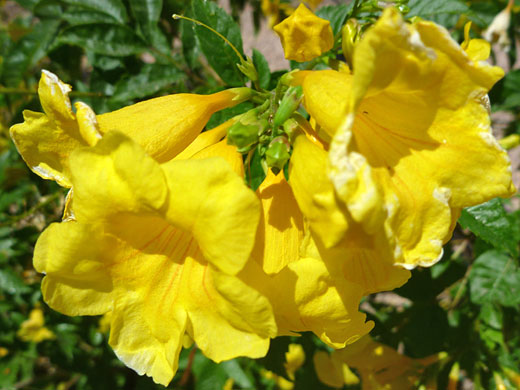Common names:
Yellow trumpetbush, yellow bells
Family:
Scientific name:
Tecoma stans
Main flower color:
Range:
South Arizona, south New Mexico and south Texas
Height:
Up to 10 feet
Habitat:
Rocky hillsides, pine woodland, disturbed areas, up to 5,500 feet
Leaves:
Pinnately divided into lanceolate leaflets, between 2 and 4 inches long, with toothed edges
Season:
April to October
Tecoma stans is found across much of tropical America, extending north into the southern parts of Arizona, New Mexico and Texas. The plant is a large, often unevenly-shaped shrub, up to ten feet tall though usually in the range three to six feet, with many branches bearing abundant, large, shiny green leaves, which are divided into 1 to 9 (usually 3 to 7) elliptic leaflets, toothed along all or part of their edges. This species is a popular choice for landscaping and gardens owing to the large, attractive flowers, the long blooming period (spring to fall), and the low water requirements.
The corolla has a very narrow base, supported by a five lobed calyx around a quarter of an inch in length, but widens considerably and opens to five lobes, two upper and three lower. The flower is about 2 inches long. All is yellow, though the inside of the tube is crossed by a few pale red lengthwise veins. The fruit is a narrow green pod, up to 8 inches long, containing yellow seeds. Flower clusters tend to hang downwards due to their own weight.
The corolla has a very narrow base, supported by a five lobed calyx around a quarter of an inch in length, but widens considerably and opens to five lobes, two upper and three lower. The flower is about 2 inches long. All is yellow, though the inside of the tube is crossed by a few pale red lengthwise veins. The fruit is a narrow green pod, up to 8 inches long, containing yellow seeds. Flower clusters tend to hang downwards due to their own weight.
All Contents © Copyright The American Southwest | Comments and Questions | Contribute | Site Map



